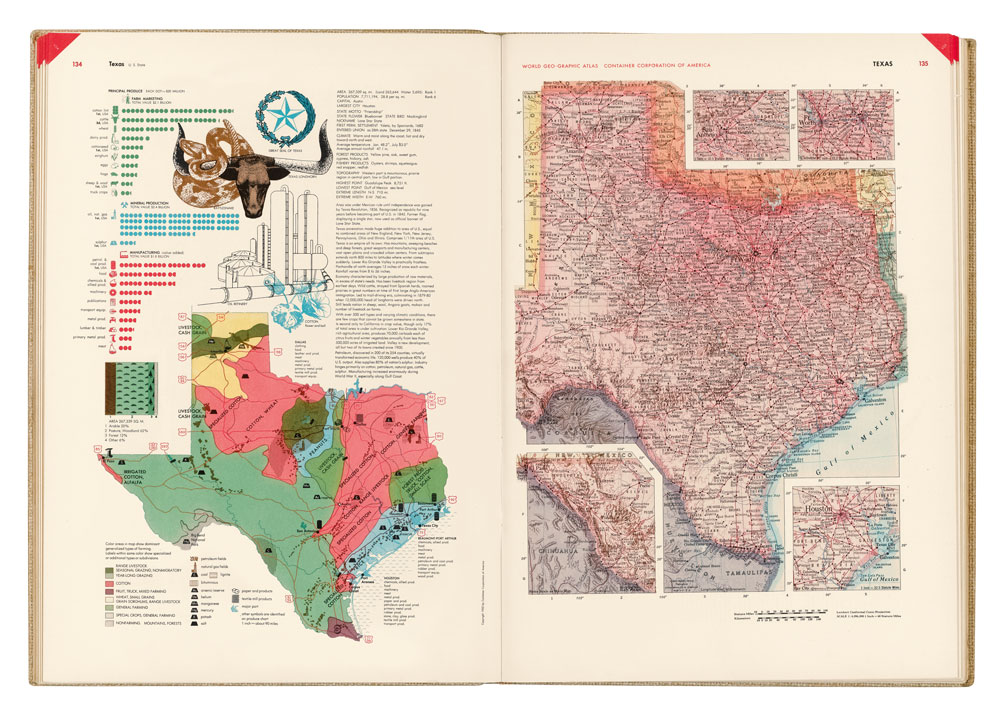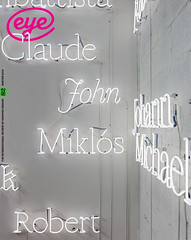Winter 2011
Big business, big world
Herbert Bayer’s World Geo-Graphic Atlas, 1953

Long before multinational corporations discovered the usefulness of corporate social responsibility (CSR) in ameliorating a public relations disaster, companies such as the Container Corporation of America (CCA) were pursuing the profit motive with a socially aware ethos embedded in practice.
Top: a spread from World Geo-Graphic Atlas: A Composite of Man's Environment. Edited and designed by Herbert Bayer. Published in 1953 by the Container Corporation of America.
In 1949 Walter Paepcke, chairman of the Chicago-based manufacturer of corrugated boxes, asked Herbert Bayer to create a book that would reflect on the new geopolitical realities of the postwar world for CCA’s 25th anniversary in 1953.
Formerly director of advertising and printing at the Bauhaus, Bayer (1900-85) had emigrated from Berlin in 1938, after his work was included in the Nazi ‘Degenerate Art’ exhibition, and established a flourishing design practice in New York. For this project the Austrian designer supervised a team of three – Henry Gardiner, Masato Nakagawa and Martin Rosenzweig – over a four-year period.
The result is a stupendous object. Measuring 280 × 400mm high, the Atlas is housed within a cardboard slipcase printed in an enlarged moiré pattern that is repeated, in different colours, as the book’s endpapers. Bound in burlap with the title debossed and gilded to the front and spine, its 368 pages are printed in four-colour process plus six other spot colours, and gilt-edged.
As well as detailed maps, the Atlas’s double-page spreads employ and combine more than 2200 diagrams, graphs, charts, illustrations and symbols. The modern language and grammar of Isotype sits adjacent to old engravings of a sheaf of corn, or animals, while great swirls of overprinted shapes fuse with Buckminster Fuller’s Dymaxion projections and sans serif asymmetrically arranged text.
The book was given to customers and distributed free to more than 150 colleges and universities across the United States. It cost the cca more than half a million dollars.
The Atlas’s underlying imperative to protect and preserve the planet prefigured contemporary concerns about ecology and finite resources. ‘Swiftly spreading global communications and increasing interdependence of all peoples compel us to consider the world as one,’ Bayer said. ‘This Atlas places emphasis on the physical and material background against which man is set.’ The Geographical Review in 1955 described it as ‘the handsomest and best atlas ever published in America’. Few atlases produced since that time convey so much with such clarity of purpose.
Peter Brawne, graphic designer, London
First published in Eye no. 82 vol. 20, 2012
Eye is the world’s most beautiful and collectable graphic design journal, published quarterly for professional designers, students and anyone interested in critical, informed writing about graphic design and visual culture. It is available from all good design bookshops and online at the Eye shop, where you can buy subscriptions, back issues and single copies of the latest issue.

